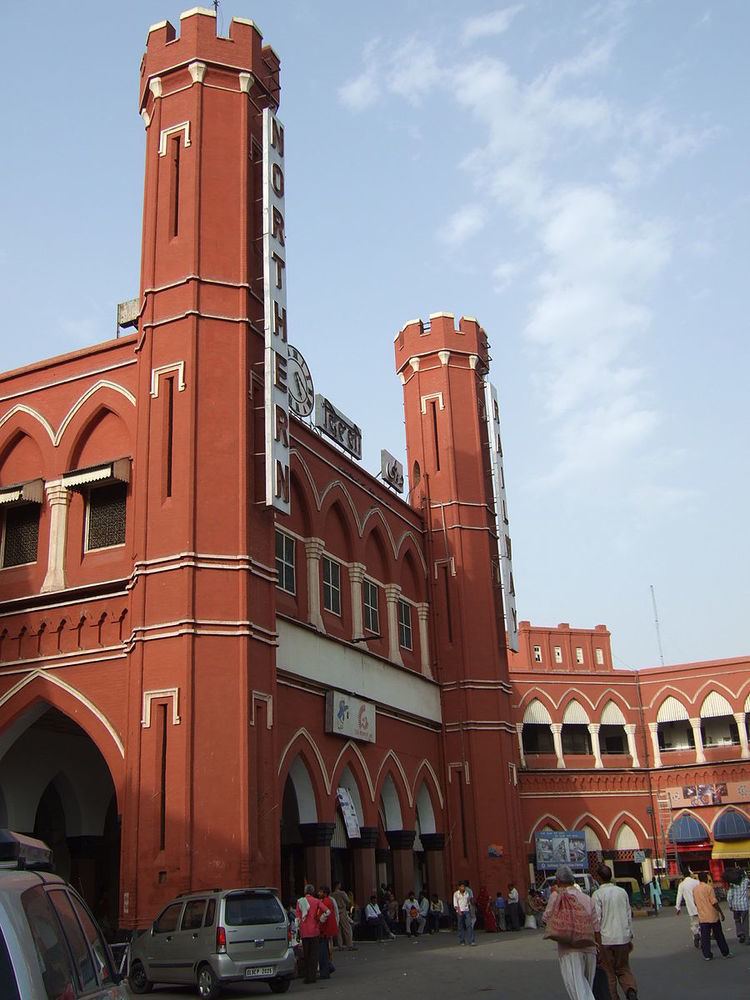Station code DLI Phone 1800 11 1139 Opened 1864 | Elevation 219 m Rebuilt 1903 Platforms in use 16 | |
 | ||
Electrified 1967; 50 years ago (1967) | ||
Delhi railway station
Delhi Junction, also known as Old Delhi Railway Station (station code DLI), is the oldest railway station of Delhi city and a Junction station. It was established near Chandni Chowk in 1864 when trains from Howrah, Calcutta started operating up to Delhi. Its present building was constructed by the British Indian government in the style of nearby red-coloured fort and opened in 1903. It has been an important railway station of the country, and preceded the New Delhi Railway Station by about 60 years. Chandni Chowk underground station of the Delhi Metro is near it.
Contents
History
The station started with a broad gauge train from Calcutta in 1864. Metre gauge track from Delhi to Rewari and further to Ajmer was laid in 1873 by Rajputana State Railway and metre gauge trains from this station started in 1876.
The present building of the station was built in 1900 and opened for public in 1903. Started with just 2 platforms and 1000 passengers, Delhi Railway Station now handles more than 180,000 passengers and 200 trains daily.
In 1904 the Agra-Delhi line was opened. Delhi then was a part of six railway systems. East Indian Railway, North-Western Railway, and Oudh and Rohilkhand Railway entered from Ghaziabad crossing the Yamuna river. Delhi - Ambala Cantonment - Kalka Railway ran northwards from Delhi, and the Rajputana-Malwa Railway traversed the Delhi district for a short distance in the direction of Gurgaon and Rewari Junction.
Delhi Railway Station was built in red stone to give the effect of nearby historic Red Fort. The station building had six clock towers and tower 4 is still in use as a water tank.
This station served as the main station of Delhi, hosting junction of four railways until the opening of New Delhi Railway Station in 1926 ahead of the inauguration of the New Delhi city in 1931. Agra-Delhi railway track cut through the site earmarked for the hexagonal War Memorial (now called India Gate) and Kingsway (now called Rajpath). East Indian Railway Company shifted the line along the Yamuna river and opened the new track in 1924.
The station was remodelled in 1934–35, when its platforms were extended and power signals were introduced. A new entrance from Kashmere Gate side was created in 1990s and new platforms were added. The platforms were renumbered in September 2011. The numbers that started from Kashmere Gate entrance as 1A and ended at 18 near the main entrance were renumbred starting as 1 from the main entrance and ending at 16 at Kashmere Gate entrance and some platforms were merged to form long platforms to accommodate trains of 24 coaches. The station building is being renovated in 2012-13.
Rooftop Solar Power
Vivaan Solar, a Gwalior based company has won the contract to install 2.2 MW of rooftop solar project at the railway station in late 2016. The solar power project to be set up under Public Private Partnership will be executed on design, build, finance, operate and transfer (DBFOT) basis. The company will also be responsible for maintainance of the plant for a period of 25 years.
Junction
Railway lines from four routes connect at the Delhi Junction:
Importance
Samjhauta Express departs from this station to Lahore, Pakistan.
